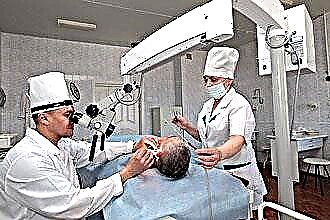Palatine tonsils (tonsils) - lymphadenoid formations that are located behind the palatine arches between the pharynx, oral and nasal cavities. Paired organs contain immunocompetent cells (neutrophils, phagocytes, T-lymphocytes), which prevent the penetration of pathogenic flora into the ENT organs. In the case of a decrease in the reactivity of the body, the tonsils become inflamed, which leads to the development of infectious diseases.
 What to do if the tonsils are swollen and it hurts to swallow?
What to do if the tonsils are swollen and it hurts to swallow?
Hypertrophy and soreness of the palatine tonsils signals inflammation of the lymphadenoid tissues. Catarrhal and purulent processes can be provoked by pathogenic viruses, fungi or bacteria. The principles of treatment largely depend on the nature of the infectious agent.
Timely passage of antimycotic, antiviral or antibiotic therapy prevents the spread of inflammation and the development of severe complications.
Functions of the tonsils
The tonsils can be called the first line of defense of the respiratory system against the penetration of pathogenic microorganisms. They take part in the synthesis of immunocompetent cells and the neutralization of pathogenic viruses, fungi and microbes. Together with the lingual, pharyngeal and tubal tonsils, they form the so-called pharyngeal ring, which prevents the development of opportunistic microorganisms in the airways.
The follicles and lacunae of the glands contain immune cells that neutralize and destroy pathogens that enter the ENT organs with air, water and food. In the case of a decrease in the body's resistance, the number of neutrophils and phagocytes in lymphadenoid accumulations decreases, which can cause organ inflammation. A decrease in local immunity can be provoked by:
- deficiency of vitamin A, B and C;
- hypothermia and overheating of the throat;
- chronic diseases;
- autoimmune disorders;
- instability of hormonal levels;
- untimely treatment of stomatitis;
- addictions (smoking, alcohol abuse);
- irrational intake of antibiotics and hormonal agents;
- injury to the mucous membranes of the pharynx.
As a rule, pain in the glands signals the presence of inflammatory processes in the tissues. According to concomitant symptoms and local manifestations, the type of ENT disease and the subsequent treatment regimen for the patient are determined.
Etiology
Why do the tonsils hurt and it hurts to swallow? Discomfort when swallowing saliva indicates the presence of pathological processes in the tonsils. The following types of pathogens can provoke the development of septic inflammation in tissues:
- adenoviruses;
- coronaviruses;
- rhinoviruses;
- influenza virus;
- herpes viruses;
- mycoplasma;
- chlamydia;
- staphylococci;
- streptococci;
- pneumococci;
- diphtheria bacillus.
Glandular hypertrophy can be a manifestation of sexually transmitted diseases, in particular syphilis and gonorrhea.
Penetrating into the tonsils, pathogens secrete specific enzymes that lead to tissue destruction. Inflammation and edema of lymphadenoid formations stimulates irritation of pain receptors (nociceptors), resulting in uncomfortable sensations - perspiration, a feeling of squeezing, cutting and throbbing pains.
Possible diseases
In most cases, pain in the glands occurs against the background of septic inflammation of the lymphoid tissues. The development of ENT disease may additionally be indicated by hyperemia and edema of the mucous membranes, myalgia, fever, cough, etc. Frequently diagnosed pathologies accompanied by discomfort in the throat area include:
- sore throat;
- chronic tonsillitis;
- chronic pharyngitis;
- paratonsillar abscess.
The glands can also swell due to mechanical damage to the mucous membranes of the oropharynx. Violation of the integrity of the ciliated epithelium leads to a decrease in tissue reactivity, as a result of which the development of septic inflammation is not excluded. Hypertrophy of the tonsils is dangerous by tissue edema and narrowing of the inner diameter of the airways. Untimely relief of catarrhal processes can lead to stenosis of the pharynx and acute asphyxia.
Angina
 Angina is called an ENT disease, in which there is an acute inflammation of the main components of the pharyngeal ring. Often, infectious-allergic inflammation is provoked by bacterial pathogens - streptococci, staphylococci, meningococci, etc.
Angina is called an ENT disease, in which there is an acute inflammation of the main components of the pharyngeal ring. Often, infectious-allergic inflammation is provoked by bacterial pathogens - streptococci, staphylococci, meningococci, etc.
The development of the disease is facilitated by hypothermia, hypovitaminosis, trauma to the glands, chronic rhinitis, and disturbances in the functioning of the autonomic nervous system.
In case of infection of the respiratory system, not only the palatine tonsils can hurt, but also the lymphoid tissues inside the pharynx.
With the development of angina, patients most often complain of the following symptoms:
- discomfort when swallowing;
- hyperthermia;
- myalgia;
- nausea;
- enlarged lymph nodes;
- headache;
- lack of appetite.
The disease always begins with sore throat, low-grade fever and general symptoms of intoxication.
The development of angina may be preceded by bacterial rhinitis, sinusitis, ARVI and other colds. A decrease in the reactivity of the body stimulates the reproduction of opportunistic microbes, as a result of which infectious lesions arise.
Inadequate treatment of angina leads to an increase in the concentration of pathogen metabolites in the body, as a result of which infectious-toxic shock develops.
Through the fascial spaces in the neck, pathogens can enter the chest and cranial cavity. Untimely relief of pathological processes leads to the development of meningitis, mediastinitis, paratonsillar abscess, etc. Streptococcal flora, which eventually affects the joints, heart and kidneys, is a particular danger to the patient's health.
Chronic tonsillitis
 Chronic tonsillitis is a sluggish inflammation of the pharyngeal tonsil and glands, in which the mucous membrane of the pharynx is damaged. As a rule, the disease is preceded by acute inflammation of the palatine tonsils, diphtheria, scarlet fever and other "childhood" pathologies. In the absence of complications, only local manifestations signal the development of chronic tonsillitis:
Chronic tonsillitis is a sluggish inflammation of the pharyngeal tonsil and glands, in which the mucous membrane of the pharynx is damaged. As a rule, the disease is preceded by acute inflammation of the palatine tonsils, diphtheria, scarlet fever and other "childhood" pathologies. In the absence of complications, only local manifestations signal the development of chronic tonsillitis:
- hyperemia of the mucous membranes of the oropharynx;
- hypertrophy of the palatine tonsils;
- purulent accumulations (tonsillolitis) in the lacunae of the tonsils;
- thickening of the palatine arches;
- enlargement of the submandibular lymph nodes.
Persistent lymphadenitis, hyperthermia and disturbances in the work of the heart signal the development of toxic-allergic tonsillitis. Chronic inflammation of the glands is often accompanied by abscesses, inflammation of the sinuses, middle ear, and kidneys. The key etiological factor in the occurrence of ENT pathology is β-hemolytic streptococcus.
The main role in the pathogenesis of chronic inflammation of the glands is played by a functional disorder of the autonomic nervous system. The development of pathology is facilitated by local hypothermia, chronic inflammation of the nasopharynx, unfavorable climatic conditions, poor nutrition, etc. Frequent relapses of tonsillitis provoke the formation of scars in the lymphadenoid tissues, as a result of which their drainage function is impaired. As a result, pathological exudate from pus, detritus and pathogens begins to accumulate in the lacunal of the tonsils.
Chronic pharyngitis
In chronic pharyngitis, inflammation of the lymphadenoid tissues of the pharynx is observed, which spreads to the palatine and pharyngeal tonsils. The causative agents of an infectious disease can be staphylococci, pneumococci, adenoviruses, influenza virus and Candida fungi. Often, chronic pharyngitis occurs due to the spread of pathogenic flora beyond the lesions.
 Chronic pharyngitis differs from a sluggish sore throat in the prevalence of foci of inflammation. Pathogens can be localized not only in the glands, but also in the pharyngeal mucosa. The development of the disease is most often signaled by:
Chronic pharyngitis differs from a sluggish sore throat in the prevalence of foci of inflammation. Pathogens can be localized not only in the glands, but also in the pharyngeal mucosa. The development of the disease is most often signaled by:
- unproductive cough;
- sore throat;
- subfebrile fever;
- dry mucous membranes;
- swelling of the pharynx;
- soreness when swallowing saliva.
A hallmark of the development of pharyngitis is ulceration of the posterior pharyngeal wall and the absence of purulent inflammation in the tonsils.
Paratonsillar abscess
Paratonsillitis (paratonsillar abscess) is an infectious lesion of the periaminal cell, accompanied by extensive edema of lymphoid tissues. Unilateral and bilateral abscess occurs as a result of septic inflammation of the glands and nearby tissues. Due to the reduced reactivity of the body, small children and the elderly are more susceptible to pathology.
If the tonsils hurt for a long period, this can lead to generalization of pathological processes and difficulty in breathing. The development of paratonsillitis is evidenced by the following clinical manifestations:
- high temperature (over 39 °);
- enlarged lymph nodes;
- labored breathing;
- spasm of the chewing muscles;
- hypertrophy of the glands;
- increasing pain when swallowing;
- weakness and nausea.
 Late passage of drug therapy leads to barley vein thrombosis and infectious toxic shock.
Late passage of drug therapy leads to barley vein thrombosis and infectious toxic shock.
An abscess of lymphadenoid tissues is fraught with the development of mediastinitis and sepsis, therefore, treatment should be started when the first signs of ENT pathology appear.
It should be noted that taking antibacterial agents during the treatment of respiratory diseases does not reduce the likelihood of developing paratonsillitis. Therefore, in case of deterioration of health, you should seek the help of a specialist.
Other reasons
Why is there discomfort when swallowing saliva? Flushing and sore throat is not always due to the development of an infectious disease. Unpleasant sensations when swallowing often result from mechanical irritation of the mucous membranes of the respiratory system. Factors contributing to the onset of a symptom include:
- smoking - tobacco smoke burns the mucous membranes of the oropharynx and destructively affects gas exchange in the tissues, as a result of which irritation of the ciliated epithelium occurs;
- inhalation of dry air - insufficient air humidity leads to drying out of the mucous membranes of the airways and, as a result, the occurrence of discomfort;
- the influence of volatile chemicals - toxic substances contained in household chemicals destroy the membranes of the cells of the ciliated epithelium, which inevitably leads to a violation of the secretory function of the mucous membranes;
- allergies - pollen, animal hair, dust particles provoke allergic reactions in the respiratory organs, resulting in edema and inflammation of the lymphoid formations.
Before starting treatment for palatine tonsils, you need to establish the cause of the problem. In the case of septic inflammation of tissues, the patient will be prescribed drugs of etiotropic (antibiotics, antiviral agents, antimycotics) and palliative (antipyretics, analgesics) action. If the sore throat is caused by an allergic reaction, antihistamines and anti-inflammatory drugs will help eliminate the discomfort.

 Glandular hypertrophy can be a manifestation of sexually transmitted diseases, in particular syphilis and gonorrhea.
Glandular hypertrophy can be a manifestation of sexually transmitted diseases, in particular syphilis and gonorrhea.

